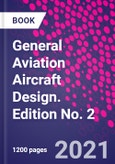General Aviation Aircraft Design: Applied Methods and Procedures, Second Edition continues to be the engineers' best source for answers to realistic aircraft design questions. The book provides design guidance for additional general aviation aircraft such as seaplanes, canards, UAV, and supersonic business aircraft. It also provides important tools and examples for aircraft sizing and design for good handling characteristics, and includes new chapters on:
- Thrust Modeling for Turbojet and Turbofan Engines - Longitudinal Stability and Control - Lateral Stability and Control - Directional Stability and Control - Dynamic Stability and Control
Written by an engineer with over 20 years of design experience, professional engineers, aircraft designers, aerodynamicists, structural analysts, performance analysts, researchers, and advanced aerospace engineering students will value this book as the classic go-to for aircraft design.
- NEW: The printed book is in color!
- NEW: Design formulation for electric aircraft!
- More material, that includes three new chapters and two appendices.
- Every chapter has been revised for more concise presentation.
- 1011 Figures, illustrations, and graphs. Multiple new illustrations. Previous illustrations revised.
- Discusses the most frequently used methods in conceptual aircraft design- Covers various handling and stability topics such as roll, yaw, pitch competing control authority especially at low speeds, and the effects of uncommanded thrust/pitch reversal on control- Features updated material to all the chapters including new sections to chapter 4 (Aircraft Conceptual Layout) and chapter 7 (Selecting the Power Plant), the addition of chapters on stability and control directed squarely at GA aircraft design and sizing, as well as regulations updated to "new" 14 CFR Part 23- Uses real-world examples and actual aircraft designs such as the Cirrus SR-22, solved examples, and derivations
Table of Contents
1. Aircraft design process 2. Aircraft cost analysis 3. Initial sizing 4. Aircraft conceptual layout 5. Aircraft structural layout 6. Aircraft weight analysis 7. Selecting the power plant 8. The anatomy of the airfoil 9. The anatomy of the wing 10. The anatomy of lift enhancement 11. The anatomy of the tail 12. The anatomy of the fuselage 13. The anatomy of the landing gear 14. Thrust modeling for gas turbines 15. Thrust modeling for propellers 16. Aircraft drag analysis 17. Performance introduction 18. Performance take-off 19. Performance climb 20. Performance cruise 21. Performance range analysis 22. Performance descent 23. Performance landing 24. Longitudinal stability and control 25. Lat-dir stability and control 26. Miscellaneous design notes
Appendix A. Atmospheric modeling B. Aerospace engineer's formula sheet C. Design of biplanes and seaplanes D. Derivation of landing side-constraint
Authors
Gudmundsson, Snorri Snorri Gudmundsson, Department of Aerospace Engineering, Embry-Riddle Aeronautical University. From 1995-2009, Dr. Gudmundsson served as Manager of Aerodynamics Engineering at Cirrus Design Corporation. He has performed testing, analysis, and performance analysis review on variety of single and twin engine small aircraft. He is also a Consulting Designated Engineering Representative for the FAA as a Structural and Flight Analyst.Dr. Snorri has a Youtube channel on Aircraft Design: https://www.youtube.com/channel/UCS0O5jdhFrdYBFC5YJP6axg/








